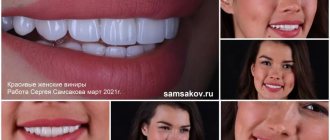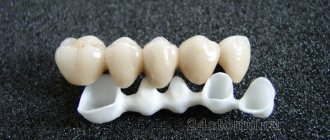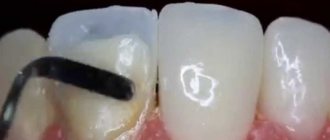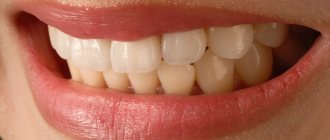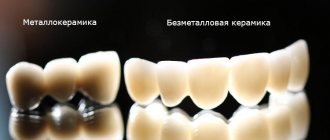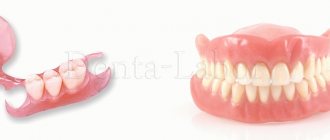A beautiful smile is a person’s calling card. The condition of your teeth affects not only your physical but also your mental health. It is also an indicator of success.
Previously, dentistry used dental crowns to restore even slightly damaged teeth. To do this, they had to sacrifice their natural teeth and subject them to severe grinding. Or remove the coronal part completely.
Now technologies make it possible to eliminate defects on the surface of the tooth, practically without processing it. For this, ultra-thin plates are used that are fixed on the outside of the tooth - veneers. The most popular of them are ceramic veneers, which have a high degree of aesthetics.
What it is?
Despite their ultra-thinness, the strength of the plates is comparable to the hardness of natural tooth enamel. The material allows you to repeat the shape of the tooth with maximum accuracy, hiding visible defects on its surface.
The demand for ceramic veneers is due to their practicality and full compatibility with the human body. The pads are non-toxic, do not cause allergic reactions, and do not require addiction. The translucent material is identical to natural tooth enamel. The shade scale allows you to select the color of the veneers that is similar to the shade of the patient’s teeth.
There are no problems with installing veneers: the plates are attached to the outside of the tooth using a dental compound.
Service life of veneers: how long they stay on the teeth, service life and durability
- 5 year guarantee in the contract
- 24/7 in touch with the clinic and attending physician
- All treatment is carried out under a Carl Zeiss microscope
- Over 12 years, more than 6,300 happy smiles, thanks and recommendations
- The financial plan drawn up at the beginning of treatment does not change until the end, and there are also no hidden fees
Most dental clinics on the Moscow market provide a 1-year guarantee. We, TopSmile clinic, are confident in our work and stipulate in the contract a 5-year guarantee for all types of work. For our patients, we also have a system for extending the five-year warranty to a lifetime.
To understand how long veneers can last, let's figure out what they are and how they are installed.
Dental veneers are a special coating or thin plates that are applied to the front of the front teeth.
Today, this is the most effective and fastest way to get rid of cosmetic imperfections such as darkening of the enamel, chips, crooked teeth, etc.
The service life of veneers largely depends on the material from which they are made and the installation method. TopSmile dentistry uses two methods of dental restoration - direct and indirect.
Indirect manufacturing method
This method is used to install ceramic veneers, ceramics and lumineers - ultra-thin plates. All of them are manufactured in the clinic’s technical laboratory using special equipment.
Ceramic plates are an ultra-thin material with which, with minimal dental treatment, you can achieve natural white teeth and hide minor imperfections, as well as become the owner of a real Hollywood smile.
pros
Fixing veneers is the fastest and most painless way to restore the aesthetics of teeth. Yes, the teeth are pre-treated. However, turning is no more than 0.5 mm.
The minimum duration of the procedure is associated not only with the immediate installation of veneers, but also with the number of visits to the dentist. If the patient does not require pre-treatment, the entire process will require no more than 3 visits to the doctor.
Important: you should not trust advertising that promises a Hollywood smile using veneers in one session. The plates are made in a dental laboratory based on previously taken impressions of the patient’s jaw. The work is complex, requiring extreme concentration and high professionalism. Therefore, it is impossible to create ceramic veneers in an hour or even in 2 hours.
Some methods of prosthetics require a long period of getting used to new teeth. Overlays do not fall into this category. After fixing microprostheses, unusual sensations may occur due to the appearance of a foreign structure in the oral cavity. But in just a day or two, the discomfort will disappear. Ceramic veneers do not affect the patient’s usual lifestyle, eating and diction.
Long service life is one of the main advantages of the plates. On average, veneers “live” for at least 15-20 years. When used correctly, of course. In addition, microprostheses can be installed in patients with high sensitivity - rejection and allergic reactions are excluded.
How long do lumineers last?
The service life of lumineers, announced by the manufacturer, is 20 years. Naturally, observing all the rules for their careful operation.
EXPERT OPINION
Ask a question Vagapov Zakir Irkinovich Orthodontist, work experience: 16 years “The main advantage of lumineers is that they are easily removable - for their installation the enamel is practically not injured, teeth are ground down only in rare cases, so even after the lumineers fail the patient does not have to immediately engage in restoration – the tooth remains in its original state.”
Disadvantages of the design
The main disadvantage of veneers is the price. For this reason, the procedure is not available to everyone. If we are talking about a minor flaw, then you can choose a more budget option - composite veneers. The material is applied directly to the tooth surface. And under the influence of the light flux, it gradually, layer by layer, hardens, forming a plate.
If the problem is related to darkening of the enamel, you can use a professional whitening procedure. The service is less expensive, but no less effective.
Another disadvantage of plates is the grinding of teeth. No matter what thin ceramic veneers are used, it will not be possible to simply remove the structure from the teeth. You will need to install a new onlay or crown.
When are they needed?
Veneers are thin coverings that cover the incisal edge of the tooth and its outer part.
They are created to protect the enamel from negative external influences, giving them a well-groomed and healthy appearance. They are used to eliminate the following problems:
- Chips and minor damage to the enamel to prevent consequences.
- The presence of noticeable fillings or gaps between the teeth that require camouflage.
- Incorrect positioning of teeth or minor problems with bite.
- Yellowing or darkening of the enamel, as well as discrepancies in the color of the teeth.
Veneers cannot be placed on the lateral chewing units or canines, because they are intended only for the front rows. Likewise, they are prohibited if the teeth are constantly in contact or if they are severely damaged. In the first case, there is a threat of damage to the products, and in the second, there is simply nothing to attach them to.
In what cases are plates installed?
The main purpose of onlays is to eliminate aesthetic defects on the front teeth. It can be:
- Chips and cracks.
- Previously installed fillings that have changed color or cracked.
- Interdental gaps and tooth pigmentation that cannot be eliminated by professional cleaning.
- Pathological abrasion of enamel.
In addition, ceramic veneers help correct minor changes in the bite, crooked teeth, and a decrease in the volume of gum tissue.
Reviews
My dentist advised me to install a veneer on a crooked front tooth instead of wearing braces for a long time. I was surprised to learn that you can get an aesthetic result immediately and for a long time, without installing iron structures on the jaw. I chose ceramic material. The tooth was ground down (this is the most serious minus) and an onlay was installed. I’ve been going with her for 5 years, no complaints, no caries, I eat almost everything. I hope that the veneer will serve me for a long time.
Olga, Omsk
I wore composite veneers on my teeth for 6 years - by the time they were removed they had darkened and began to crumble. After them I immediately installed ceramic ones. These are much better in quality and do not change color. I have been going with them for three years and plan to go for a long time.
Inna, Moscow
Contraindications
Despite the versatility and practicality of the technique, there are limitations to the installation of veneers. For example, the use of plates is contraindicated in cases of bruxism, the presence of inflammatory processes, bone tissue pathology, and malocclusion.
Also, ceramic veneers are not used for the restoration of severely damaged teeth (more than 50%). In this case, the doctor installs crowns.
A refusal to carry out the procedure may be the presence of bad habits (biting nuts, nails, opening bottles with teeth, etc.). Or a high risk of maxillofacial injury. For example, extreme sports.
Gum disease and loss of chewing teeth will also require preliminary treatment before installing plates.
Production technology
Ceramic veneers are usually made using three techniques:
- Applying the composition to a plaster model followed by heat treatment. The dental technician evenly distributes the composition over the surface of a special material that holds the paste during firing. The technique is inexpensive and allows reducing shrinkage of the structure.
- Casting. In this case, a model of future ceramic veneers is first created using wax. Then it is fixed in a refractory mass and installed in the sprue. Processing is carried out under high temperature. At the final stage, the dental technician paints the plates in a color that matches the patient’s tooth enamel.
- Pressing (Emax). More modern technology that reduces the porosity of the material. This ensures maximum structural strength. As a result, pressed plates have a longer service life. After processing, ceramic veneers are coated with a special compound that adds shine to the overlays.
Recently, the digital method of making veneers using a milling cutter has become popular. The model for the plates is obtained using a non-contact scan of the patient's oral cavity. A computer program calculates the structure. The sample is then sent for milling. The advantages of the method are obvious: the automated process eliminates possible inaccuracies and errors in the production of microprostheses.
Lifespan of veneers and how to care for them
A service such as the installation of veneers is becoming increasingly popular in dental clinics. This is a method of dental reconstruction that has a rather aesthetic purpose. As a result of the procedure, the teeth acquire the correct shape and color.
This type of dental service is not cheap, so the question of how long veneers last on teeth is quite relevant. There are many features that affect the service life of veneers, it is better to learn about them before the procedure.
What are veneers
Many people believe that veneers are something like implants. In fact, veneers are thin shells - plates that are designed to be installed on the front tooth surface to create the appearance of straight, anatomically colored teeth.
The process of fastening products takes place in several stages. As a result, you can not only restore your teeth, but also eliminate problems with color, shape or position. Plates can be placed on one or more teeth. Such dentures do not require complex installation procedures and look natural, creating the desired “Hollywood smile.”
Modern types of veneers can serve as an alternative to dental products such as braces if there are contraindications to their installation. The advantages of dental onlays include elasticity, strength, durability and reliability. On average, depending on the type of product, the warranty period is from 5 to 15 years.
Indications and contraindications
Despite the fact that dental plates are a safe design that causes complications only in exceptional cases, they are recommended to be used only when indicated. The patient's desire alone is not enough for reconstruction.
Indications for this method of tooth reconstruction:
- damage, chipping or disruption of the natural structure (enamel);
- irregular shape;
- altered or natural “ugly” color;
- gaps or incorrect positioning;
- cracks;
- tetracycline
- hypoplasia or fluorosis;
- wedge-shaped defect.
In a professional clinic, services are not provided without preliminary diagnostics, the purpose of which is to identify the possible presence of contraindications:
- abrasion of dental tissues;
- significant curvature of the tooth;
- bruxism or stomatitis;
- periodontitis, caries or pulpitis;
- periodontitis, gingivitis or periodontal disease.
The doctor may refuse to allow the patient to undergo the procedure if the bite is severely altered, or there is a significant deformation of the position of the teeth, or if there is a large filling.
It is also not recommended to place plates on people who do not sufficiently observe hygiene standards. The use of narcotic drugs is considered an absolute contraindication.
It is also not advisable for smokers to install plates, since this method of reconstruction will be pointless due to the rapid darkening of the material of the plates.
Features of the installation process
Before installing veneers, you should consult your dentist. The doctor must tell the patient about all the features of the procedure and how to use dental veneers.
Reconstruction cannot be done in one visit. The duration of recovery depends on the number of teeth.
Stages of installing veneers:
- preliminary examination of the oral cavity;
- selection of the type of linings according to individual characteristics;
- treatment of the tooth surface (removal of top enamel);
- creating an impression for making a plate;
- overlay of temporary veneers (for the period of production of the onlays);
- removal of temporary products;
- installation of manufactured records.
The procedure has a large number of advantages, but there is one disadvantage that often affects patients’ decisions about providing the service - the possible grinding down of the natural crown. This is necessary to align the tooth surface in relation to other teeth. If grinding occurs, the specialist warns the patient in advance.
Service life of veneers depending on type
Modern clinics offer a wide selection of veneers. Depending on the patient’s wishes and capabilities, the doctor will help you choose the most suitable option for overlays. Regardless of cost and material, products are always made individually.
The type of material from which the overlays are made affects the aesthetic result, as well as the service life. Expensive products have higher performance indicators.
There are three types of veneers: composite, ceramic and zirconium. There is another type of overlay, which is also called “Hollywood” - Lumineers.
Composite
Plates made of composite, which is a high-quality filling material, but at a cost, this is the most affordable option. In addition, dental patients are often attracted by the advantage of composite veneers - quick installation. But applying the material directly to the teeth in a thin layer is only suitable for minor adjustments. However, there is a drawback - the composite is stained to match the natural color of the patient’s teeth. If an impression is made, it will take more time, but this option is of better quality.
Since this is a budget option, you should understand that composite veneers have a service life and maintenance that are two interrelated concepts. When reconstructing using this method, you should carefully follow the recommendations of a specialist. On average, composite overlays will last 8 years.
Ceramic
The option of ceramic products is characterized as more durable and reliable. Their advantage is that the plates are not affected by dyes or food deposits. They continue to remain white throughout their entire service life.
The manufacturing process is standard - based on an individual cast. Such plates have another significant advantage - they do not require the procedure of cutting down the enamel. How to care for ceramic veneers, you need to consult a doctor.
Their service life can be up to 17 years.
Zirconium
Veneers made from zirconium dioxide are considered to be the most durable. The sketch for plates of this type is made using computer programs that create an individual model of the lining.
Based on this sketch, the veneer is produced on a special automatic machine. To improve the quality of the product, an additional layer of porcelain material is applied to its surface.
The overlays are characterized by a thin and transparent structure.
Zirconium veneers are distinguished by the following advantages: natural color, which does not change under any external influence, including smoking, the thinnest possible layer and biocompatibility.
The service life of zirconium dioxide veneers is the longest among all options - up to 20 years. However, these models of linings cost from 7,000 rubles per unit. The high price is justified by the method of manufacturing the product, the use of high-quality material and its service life.
Lumineers
The most expensive option is lumineers, which are used to create the “Hollywood smile” effect. Despite the fact that inexpensive material (ceramics) is used to create the plates, the service life of such veneers is the same as that of zirconium veneers - 20 years.
Lumineers differ from ceramic onlays in thickness; the “Hollywood” version is twice as thin and does not require tooth grinding. However, unlike zirconium dioxide products, they have a significant drawback - the natural color of the enamel shines through them; if it is dark, then the aesthetic appearance will no longer have the desired effect.
As a result, we can conclude that the service life of veneers depends mainly on the material from which they are made and the method of their creation.
But product care and compliance with recommendations, which is based on the characteristic features of the material (for example, dye sensitivity, thin layer, etc.), can also have an impact on reducing the operating time. The condition of the teeth themselves also plays a certain role.
If there are dental problems, you should get rid of them before reconstruction, and then visit a specialist at least twice a year for preventive purposes.
Clinic “A - Medic” is a dental center that has been providing implantology services for several years. We offer installation of high-quality veneers (ceramic, composite, lumineers, etc.) with a service life guarantee.
The clinic often holds promotions and discounts that allow you to get the “smile of your dreams” at an affordable price. On the website you can see prices for services, see photos of our patients before and after the procedure, and also read reviews about the work of specialists and the results of services provided in the clinic.
Diagnostics
The fixation of ceramic plates is carried out in three stages: preparation for the installation of veneers, production of the structure and fixation on the teeth.
Correctly performed diagnostics determines how long the orthopedic structure will serve the patient. In addition to the condition of the teeth, it is important to identify possible hidden pathologies in the bone and soft tissues of the jaw. And also carefully study the anatomical structure of the teeth being restored.
At EspaDent clinics, specialists conduct radiographic examinations for more accurate diagnosis. In complex cases, a modern 3D tomograph is used, which creates three-dimensional, layer-by-layer images of both jaws. During a consultation in our clinics, the doctor will offer the best options for microprostheses and immediately indicate the cost of the procedure.
Pak Roman Vladimirovich
Specialization: orthopedic dentist Work experience: more than 25 years Place of work: Dentistry ROOTT m. Butyrskaya/dd> Specialist in the field of dental prosthetics:
- microprosthetics – veneers, inlays (ceramic, based on precious metals), stump inlays;
- fixed prosthetics with solid cast, metal-ceramic, all-ceramic, metal-ceramic based on drags. metal structures;
- prosthetics on implants;
- removable prosthetics – production of complete, partial, nylon, clasp removable dentures with various types of locking fasteners and a telescopic fixation system.
How does the installation work?
If the patient does not require preliminary treatment, the next step is professional oral hygiene. The dentist removes hard and soft plaque from the teeth and disinfects the oral cavity. Before treating the teeth, the specialist selects the color of future ceramic veneers according to the Vita shade scale. Grinding of teeth is carried out in a gentle manner, without pain. If necessary, safe local anesthesia is used.
Next, the doctor proceeds to taking impressions of the teeth. According to the chosen method, first a model of the plates is made, and then the final microprosthesis. On average, the production of ceramic veneers takes 1-2 weeks, depending on the complexity of the design.
While the patient waits for new veneers, temporary plastic or composite veneers are fixed to the treated teeth. Onlays protect your natural teeth from bacteria. They also provide chewing function before the installation of microprostheses.
After the plates are ready, the doctor fixes them on the teeth one by one. Each dental unit requires approximately 30-60 minutes.
Situations that may require replacement of veneers
Old veneers should be removed from teeth and new ones should be installed purely based on the wear of the linings - there are no planned replacement dates or expiration dates after which the veneer would be considered unable to perform its function. If the veneer is intact, does not change color or texture, does not have chips and does not peel off from the tooth stump, then it can be worn further. If any defect appears on it, it must be changed, and immediately upon discovery of this defect, without waiting until any formal deadlines.
Reasons for replacing veneers are:
- chips and cracks in the veneer, peeling it off from the tooth. These mechanical damages are usually visually noticeable, and sometimes also felt by touch with the tongue;
- hue changes. This happens with composite veneers - due to the fact that the original color changes, the veneer becomes too noticeable and different from your own teeth;
- caries under veneer. Alas, this also happens sometimes - even a properly prepared tooth with a well-installed veneer can be susceptible to caries, and then the solution is to remove the onlay, treat the carious lesion and install a new veneer;
- a poorly made veneer that does not match the tooth. Sometimes people come to the VivaDent clinic who have been given veneers that are not the size or shape of their teeth due to an incorrectly taken impression, poor fit, or poor quality work of the dental laboratory. Such veneers objectively interfere - and at the VivaDent clinic they are replaced with new ones that exactly match the teeth.
Classification of structures
Microprostheses are distinguished by the type of material used in their manufacture. Ceramic veneers, without impurities, are considered traditional. For example, porcelain or pressed ceramics. The advantage of these plates is their impeccable aesthetics. The veneers look natural and neat on the teeth. But ceramics are far from the most durable material. It is not able to withstand significant chewing load.
To increase strength, dentistry has developed zirconium dioxide veneers. In this case, the microprosthesis consists of two layers: a zirconium base and a ceramic lining. Dental crowns are made using the same principle. Important: these plates are metal-free. It is not zirconium (metal) that is used here, but zircon, a natural white mineral. The stone has increased hardness, which allows it to be used to restore lateral teeth. However, the aesthetics of zirconium plates are far from perfect, so after production, an additional layer of ceramic is applied to the veneers. The result is durable ceramic veneers with enamel identical to natural teeth.
The third group includes lumineers - ultra-thin plates. The thickness of the onlays does not exceed 0.2-0.3 mm, which minimizes the process of grinding the teeth. The use of lumineers allows you to hide flaws in the dentition, while preserving the enamel of your natural teeth. The minimum thickness does not affect the functionality of microprostheses in any way. The plates can withstand full chewing load, without chips or cracks. However, there is also a downside: the manufacture and installation of ultra-thin veneers is similar in complexity to jewelry work. High qualifications of both the dental technician and the dentist are required. Which leads to an increase in the cost of the procedure. The cost of making lumineers can be 3-4 times higher than traditional porcelain veneers.
Types of veneers: which one will last longer?
There are several options for making veneers. The strength of the crown, and therefore its service life, depends on this. Ceramic crowns are considered the most popular in terms of reliability. For their manufacture, zirconium dioxide or porcelain is used. A cheaper option is composite veneers, which are made from ceramics or light-curing material. More details about each type:
Composite crowns
Such crowns are made using high-quality composite filling substance. Dental patients are attracted by the affordable price (about 4 thousand rubles per unit), moreover, a similar service can be obtained at an appointment with almost any dentist. According to the method of production and application, they are divided into two types:
- The first method refers to aesthetic filling. The front part of the tooth is ground and covered with a thin layer of filling substance. Such a veneer will help hide minor flaws or give tooth enamel a lighter tone.
- The production of veneers is carried out in a special dental laboratory, where a future crown is created from the resulting impression. An impression of the tooth is taken in the dental office after the doctor has sharpened its front surface. The veneer is fixed during the second visit to the dentist. This version of composite crowns allows you to hide significant enamel errors and is more reliable.
When giving your teeth perfection with composite crowns, you should not count on their long service life. Such veneers last on the enamel surface for 5 years, and the surface itself is easily painted with food coloring and changes its tone.
Porcelain
Porcelain veneers have a longer service life. Can be produced using two methods:
- Layer-by-layer application of ceramics - the material is applied in layers, where each of the applied layers is fired.
- Pressed ceramics - for the manufacture of veneers, the material used can be pressed, and the process itself occurs at high temperatures. This gives the veneer base greater strength and durability, but which of the two methods to use to make the crown is chosen by the attending physician.
It is difficult to distinguish porcelain veneers from the natural structure of enamel and only a true professional can do it. They are characterized by good resistance to staining and heavy loads. No spots of pigmented plaque appear on their surface, and the ease with which they transmit light into the depths of their structure creates the impression of complete fusion of the veneer with the natural tissues of the tooth.
The disadvantages of porcelain crowns include the need to prepare tooth enamel to a greater thickness. The crown itself is made with a thickness of about 0.7 mm, and it is this indicator that will need to be ground.
The price of porcelain veneers is about 6 thousand rubles per unit, but the service life also increases (up to 15 years).
Zirconium
Making crowns from zirconium dioxide allows you to achieve maximum strength of the product. Using special computer programs, a veneer model is created, after which it is reproduced on an automatic machine. A porcelain substance is applied to the resulting structure. Thus, the product is transparent and thin in structure. Main advantages:
- the longest service life of all existing types of veneers;
- high levels of product naturalness in structure and color;
- the color of the crown is not distorted by the light falling on it;
- resistance to food dyes;
- absence of plaque even with poor quality care or smoking;
- high levels of biocompatibility with hard and soft tissues;
- good strength with low weight.
The complexity of manufacturing such crowns affects the price. One unit of the product will cost about 7 thousand rubles, but such plates can last about 20 years.
How long the crowns will stay on the teeth depends not only on the type chosen. The physiology of teeth plays a large role in the service life; their ability to be destroyed, as well as from the food consumed and hygiene procedures.
Budget analogue
There is an easier and faster way to restore teeth. Composite veneers help with this - a polymer in the form of a paste that is applied directly to the surface of the tooth. The composition is mixed in the dentist's office, which allows you to complete the procedure in one visit. Of course, if there is no need for preliminary treatment of teeth and soft tissues.
The composite has good aesthetics and does not require significant grinding of natural teeth. Hardening is carried out layer by layer, under the influence of light flux. This provides the necessary strength to microprostheses. The technique is suitable for restoring lateral teeth.
Disadvantages of polymer restoration:
- Shorter service life compared to ceramic veneers - no more than 5-6 years.
- Instability to pigmentation. The material changes color over time and absorbs coloring components.
- Imperfect match to the shade of natural enamel.
How to extend the wearing period of veneers?
In order for veneers to last as long as possible, you will need to take proper care of them. By following simple rules, you can avoid crown darkening, abrasion or cracking.
- Minimize the consumption of acid-containing products, under the influence of which the surface of the ceramic can change significantly.
- Also, ceramics react poorly to toothpastes with a high pH content or high abrasiveness.
- Despite the fact that the crowns themselves are not subject to caries or plaque accumulation, the teeth are still cleaned during routine procedures. The plates cover only the outer part of the tooth; the back side remains unprotected. Diseases that lead to its destruction will also contribute to the chipping of the crown.
- Even the strongest veneer is installed to improve the aesthetic appearance and still remains fragile. In order for the product to last as long as possible, you will have to reconsider your diet and remove foods that will harm the integrity of the veneer or its coloring. For example, after installing crowns, you should give up solid foods in the form of nuts and those that contain artificial or natural dyes. You will have to reduce the amount of tea, red wine and coffee you drink.
A systematic visit to the dental office, even if upon independent examination of the veneer, everything seems to be in order. Only a dentist can qualifiedly examine the open area of the tooth and the veneer itself for cracks. Regular professional teeth cleaning will also help increase the service life of veneers.
The doctor who installed them will provide additional information on how to increase the service life of the installed veneers. Only he knows which crowns were used, and each type has its own operating requirements.
Sources used:
- “Direct veneers of anterior teeth” (Salova A.V.)
- Principles of operative dentistry. Qualtrough, A. J. E. Oxford, UK: Blackwell Pub. 2005.
- Orthopedic treatment of pathological abrasion of hard dental tissues / Kh.A. Kalamkarov. — M.: Medicine
- "Revised Classification System for Alloys for Fixed Prosthodontics"
Manufacturers
To protect yourself from low-quality prosthetics, check with the clinic about what materials are used in the procedure. Mainly large companies specialize in the production of ceramic veneers. There aren't many of them.
The most famous company Nobel Biocare is a leader in implantology and prosthetics. It was this manufacturer that developed the popular protocols for implantation procedures All-on-4, All-on-6, Trefoil, etc. In the case of installing veneers, the company specializes in the production of zirconium plates.
The list includes German and Japanese companies that produce their products under the brands Katana, Prettau and BruxZir Anterior. The leader in the production of pressed and solid ceramics is Ivoclar Vivadent, which specializes in Emax technology.
Many years of experience, modern materials and strict quality control allow these companies to occupy a strong position in the dental materials market.
How are old veneers removed?
Since a veneer is not just a “sticker”, but a very securely attached object to a tooth, to remove it it is not enough to pick or tear it off. It is especially stupid to try to do this on your own, at home. There are only two methods - and both can only be used in a clinical setting.
Removal using a diamond dental bur
This is a mechanical veneer filing: the dentist uses a thin rotating bur to file away the veneer and the dental cement underneath, leaving only the tooth stump. Basically, this is how teeth are removed from composite veneers.
Removal using laser
Laser technology is as follows: since porcelain and ceramic veneers are very thin and characterized by a certain transparency, the laser beam simply shines through them, destroying the cement underneath. The veneer itself is not destroyed, but falls off due to the destruction of the cement layer. However, there are types of veneers (less transparent and thicker) that cannot be removed with just a laser - then a bur is used.
The difference between composite veneers and ceramic
There is no point in trying to choose the perfect option. Each technique has its own advantages and disadvantages. For example, porcelain plates are most effective for restoring the front row of teeth, in the smile area.
On the contrary, the use of composite veneers is indicated for the restoration of chewing teeth. Plus, it's an inexpensive way to restore your beautiful smile. And, as a result, self-confidence. It is advisable to use a composite polymer for point adjustments - 1-2 teeth. While ceramics are effective for the restoration of the entire dentition.
The advantages of ceramic veneers include the quality of adhesion to the tooth surface. The onlays cover not only the front, but also the lateral parts of the dental unit. Due to this, the structure adheres better to the teeth. Ceramics does not lose its original appearance throughout its entire service life. While composite veneers fade, darken, and lose their visual appeal.
There are differences in the installation and maintenance of orthopedic structures. Polymer plates are fixed to the teeth immediately in one session. For porcelain or zirconium, it takes 1-2 weeks to produce the plates. For minor damage, the photopolymer can be corrected by sanding. But if there are chips or cracks, ceramic veneers will have to be replaced.
To maintain the aesthetics of composite plates, you will have to give up bad habits (smoking). And also do not use pigmenting products. In this case, there are no restrictions for ceramics, because the material is stain resistant.
Choose dental veneers and enjoy your smile!
Veneers aren't for everyone, but if they're an option for you, you'll get a beautiful, natural-looking smile that will last for many years. Mira clinics use German E-Max veneers made of pressed ceramics. When you need to install veneers, Krasnoyarsk turns to us! During the examination, the doctor will find out whether veneers are suitable for you and will tell you whether you will need to pre-treat your teeth.
It happens that dental veneers are not suitable for the patient. In this case, we recommend alternatives: whitening, other types of prosthetics. We will definitely figure out how to achieve a beautiful smile. And, of course, we will answer all the questions: why not composite veneers, but ceramics, how long will they last and how to care for them.
Price issue
The cost of ceramic veneers is influenced by the material, installation method, and complexity of the procedure. As well as the qualifications of the doctor and the reputation of the clinic. On average, prices for pressed ceramics start at 23 thousand rubles. Zirconium ones will cost 35 thousand and more, composite ones - from 10 thousand rubles.
If after diagnosis the patient needs dental treatment, the final cost will be higher.
At EspaDent clinics, the patient learns the final amount immediately after the initial diagnosis. No surcharges or hidden fees. For expensive procedures, our patients have the option of interest-free installments. Diagnostics and initial examination in all EspaDent clinics are free of charge.
Care instructions
After dental restoration, you want microprostheses to last as long as possible. This is a completely doable task if you follow the recommendations for caring for ceramic veneers. There are no complicated regulations. The rules are the same as for preserving natural enamel:
- Daily oral hygiene. Use a medium-hard toothbrush and a toothpaste without abrasive particles (not whitening).
- To clean the interdental spaces, it is recommended to use dental floss and rinse your mouth after eating.
- Do not eat too hard foods. Avoid sudden changes in temperature (very hot and cold food).
It is also important to visit the dentist 1-2 times a year for a preventive examination and professional oral hygiene.
In the first days after installation of veneers, unusual sensations may occur due to the appearance of foreign material in the mouth. Especially if the teeth have changed length after prosthetics. But the discomfort will disappear after 1-2 days.
Service life of veneers
Most people who decide to correct the aesthetic problems of their smile with the help of dental onlays are interested in the service life of dental veneers. The rationality of choosing microprosthetics depends on how long veneers last on teeth.
Service life of dental veneers
Often, patients with problematic front teeth have a choice between installing veneers and crowns. On the one hand, you want to preserve the vitality of the pulp and cut down as little tissue as possible. On the other hand, you don’t want to remove the onlays and install crowns after a year or two. Let's try to figure out what determines the service life of veneers, in which cases they should be installed and in which they should not be installed.
The duration of wearing the pads is very individual. It depends on:
- material for manufacturing a microprosthesis;
- bite ;
- compliance with all technical conditions and parameters in the laboratory;
- compliance with the rules of tooth treatment and fixation by a doctor;
- thorough oral care and compliance with scheduled visits to the doctor;
- presence of bad habits in the patient.
Of course, Emax veneers are considered the most durable and reliable today, their service life reaches 10-15 years . Zirconium veneers have a similar service life due to the dense frame.
Overlays made from ordinary ceramic mass last at least 5 years . At the same time, the service life of composite veneers is the shortest.
As a rule, the unit price directly corresponds to the service life of the future structure.
Service life of ceramic veneers
As you know, several types of onlays are made from ceramics: classic, on a zirconium dioxide frame, E-max ultraneers, American lumineers. They all differ in the chemical composition of the mass, its density and strength, the underlying frame, on which the service life of ceramic veneers depends.
For example, German lithium silicate ceramics E-max is baked under pressure during the manufacturing process. This rids its structure of pores and other defects that can lead to chipping. This structure allows you to create plates with minimal thickness and the most natural appearance, which look decent on the front teeth.
Considering the reviews, the service life of veneers on a zirconium dioxide frame is even higher, 10-15 years or more . The reason for this is a dense metal frame under a layer of ceramic mass, which effectively withstands any load.
But due to its presence, the natural appearance is lost; there is no translucency that is present in E-max plates. Zirconium linings have a matte finish and are thick.
Accordingly, they require cutting off a larger layer of enamel and are more suitable for lateral teeth.
Of course, E-max ceramics are expensive even at cost, and microprostheses based on them cannot be in the same price category as other types. But, if such cladding is not affordable, you can install classic ceramic linings. In any case, the service life of veneers on ceramic teeth will be longer than that of direct composite ones.
There is another type of ceramic onlay - American super-thin lumineers, which are distinguished by the fact that they do not require cutting down the enamel at all.
At the same time , veneers on American-made teeth last, according to the manufacturer, up to 20 years, although the warranty on them is only 5 years . There are also significant disadvantages - very high cost (from 700 USD).
e per unit) and a long manufacturing process, because Original Lumineers can only be manufactured in the USA.
Service life of composite veneers
The short service life of composite veneers is one of their main disadvantages. Usually, after a year, the cladding looks unsightly and requires correction or complete covering.
On average, they are worn for no more than 3 years, and during this period they can cause a lot of trouble to their owner due to cracks and chips .
And any problems that arise with the front teeth require an urgent visit to the dentist, because... are very noticeable.
The main reasons why composite veneers do not last long are:
- Porosity of the material , the ability to absorb pigments from food. This leads to rapid darkening of the cladding.
- Low strength and resistance to loads.
- Production by the direct method directly in the oral cavity, when the material is exposed to steam from breathing and moisture .
Considering reviews of how long veneers on composite teeth last, we can conclude that they act more as a temporary structure. Their installation is justified when there is an urgent need to eliminate a defect before an important event. When undergoing routine treatment, it is better to immediately choose ceramic veneers, which last two to three times longer.
Of course, with proper and regular care, even the simplest veneers can extend their shelf life. For example, if after installing composite onlays you do not eat or drink anything coloring (coffee, tea, juices) for the first week, and avoid biting hard foods while wearing them, they will retain their original appearance for a year or more.
To further increase the shelf life of veneers, you should visit your dentist twice a year for professional cleaning and joint correction . The presence of a microgap between the veneer and the tooth tissue leads to food clogging and the development of caries, which reduces the period of wearing veneers.
In addition to professional hygiene, daily tooth brushing is extremely important for all types of veneers. Caring for composite veneers also involves the correct selection of hygiene products.
The composite material is sensitive to toothpaste; if it contains too large abrasive particles, it can wear off.
If you choose a more gentle toothpaste with small particles, you can extend the service life of veneers on your teeth, avoiding their premature wear.
To prevent problems such as chips and cracks, you should forget about the habit of biting off threads with your teeth, opening bottles, gnawing crackers and nuts . If nighttime grinding (bruxism) is present, a mouth guard can be made to protect the guards from damage.
Lifetime
Depending on the type of structure, the service life is determined. For example, plates that overlap the cutting edge, according to research results, turned out to be a more reliable product.
Overlays made of pressed ceramics are considered to be the most durable. The material is able to retain its original properties for up to 12-15 years, without deteriorating in appearance. Here, it is not the ceramic veneer that wears out to a greater extent, but the cement on which it is attached.
Zirconium plates are not far behind in reliability. Their lifespan is at least 10-15 years. The most expensive lumineers, with proper care, will delight their owner for up to 20 years.
Wear resistance is directly affected by the quality of production and installation of the plates. Porcelain veneers that do not fit tightly to the surface of the tooth can crack or even fall out. And bacteria will accumulate in the space between the tooth and the plate, which will lead to the appearance of carious cavities. Therefore, it is important to carefully choose a clinic and a doctor for prosthetics and dental treatment procedures.
Dental veneers
In dentistry, veneers are called unique crowns (microprostheses). Such designs differ from conventional crowns in their thickness and location on the tooth. If the crown is put on like a cap completely over the entire tooth and at the same time requires its sharpening, then the veneer is installed only on its outer surface. The thickness of the veneer will depend on the existing problem and the material used for their manufacture (up to 0.7 mm).
Such crowns allow you to give your teeth a natural aesthetic shade, correct minor deviations in the anatomy, and create a protective coating for tooth enamel, which will increase its resistance and strength to aggressive influences. Veneers will also help hide minor gaps between teeth.
The material from which veneers are made is fragile, so such crowns cannot be installed in gaps where a tooth is missing, on the surface of chewing incisors, or for support during bridge prosthetics.
The service life of teeth plates depends on many factors, namely:
- carrying out correct hygiene procedures;
- compliance with operating requirements;
- from the material that was used to make them.
Let's analyze in more detail how to choose crowns with a long service life and what to do to extend it?
